Experiencing cloudy water in your fish tank after a water change can be a common frustration for aquarium enthusiasts, often leading to frantic searches for solutions. In this informative piece we dive into the causes behind this issue, address misconceptions and offer practical remedies.
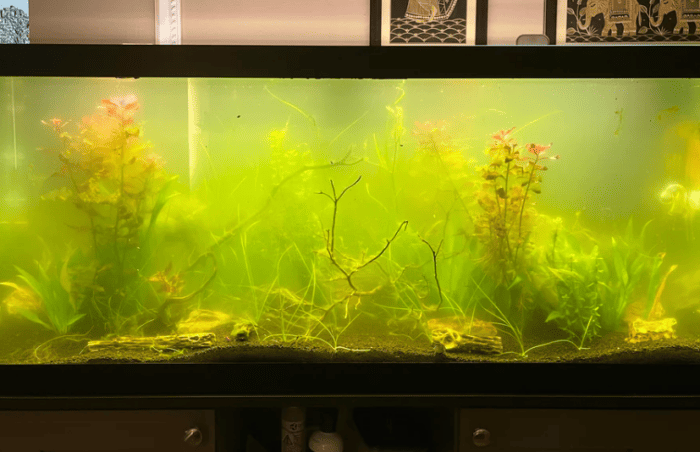
If you have noticed your fish tank keeps getting cloudy after a water change, then you’re not alone.
Cloudy water is actually one of the first issues many beginners face.
This often leads them into a frenzied hunt for answers that results in rash decisions which only make things worse.
Even though your mind may be wrought with disastrous thoughts, you shouldn’t lose hope and panic. The cloudiness in this case, is typically the result of a bacterial bloom provoked by the easily accessible nutrients in your tap water.
The sudden change in your aquarium water is completely natural and you can deal with it in several ways.
It’s something I’ve faced multiple times in the past, and I’ll share why it happens and how you can get rid of it in this post.
Why is your fish tank cloudy after a water change?
Regular water changes are an essential part of the maintenance of our aquariums. They remove the nitrate buildup and help us maintain the pH levels of the water stable.
This keeps our fish healthy and sound, while we reap the benefits of their lively company.
Unfortunately, sometimes things take a turn for the worse.
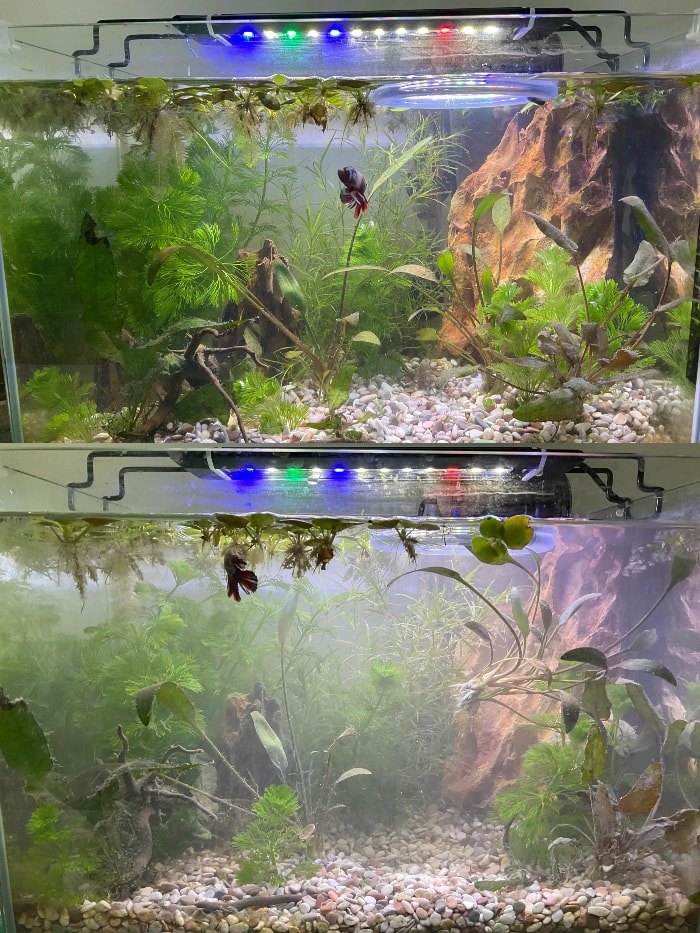
This is when we resort to the internet in hopes of an answer that will put a stop to the pestering questions that can’t stop bothering us.
Here’s why your aquarium water has become cloudy after your last water change:
Heterotrophic bacteria are one of the most common types of bacteria in household aquariums. When there’s a partial water change, they feed on the organic compounds from the new water and start to multiply rapidly. This leads to a bacterial bloom which clouds the aquarium.
Unlike autotrophic bacteria which double their numbers in 16 to 24 hours, it takes only 15 to 60 minutes for heterotrophic bacteria to double theirs.
As a result, they have no time to colonize the different parts of the aquarium and saturate the water column instead.
That’s why the change in water quality typically becomes noticeable after 1 or 2 days.
In marine aquariums, the water often becomes foggy due to a lack of magnesium after a water change.
This leads to the formation of small white particles that eventually shroud the entire tank.
Depending on the underlying reason, murky aquarium water might prove to be more than just an eyesore.
Will cloudy water hurt your fish?
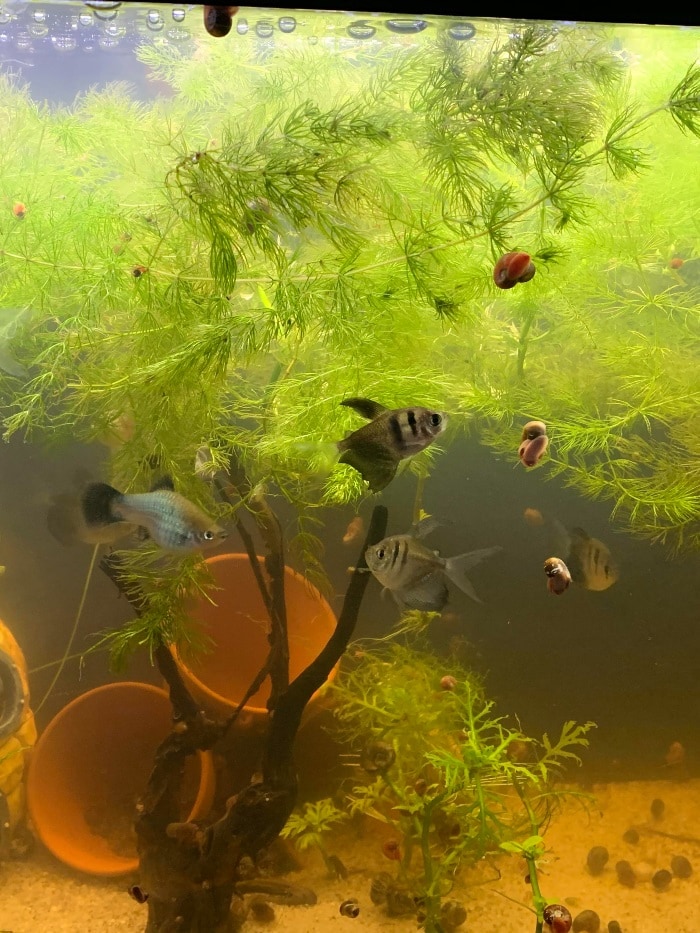
To help you understand how cloudy water can affect the health of your fish, I will take a step back.
Remember the second type of bacteria I used to exemplify how fast heterotrophs replicate?
Well, autotrophic bacteria are something you’re actually already familiar with.
These are the same types of bacteria that are responsible for the nitrogen cycle in your tank. While heterotrophic bacteria break down organic matter and use it as a form of energy, the beneficial autothrophs feed on the non-organic compounds that are left.
Consequently, when there’s a bacterial bloom in your aquarium, there’s a high chance the amount of ammonia and nitrates will also increase. Moreover, the bacterial activity in such a scenario will also steadily decrease the pH of your water.
Both of these conditions have detrimental effects on fish health and might end up destroying your entire tank if the bacterial bloom goes unaddressed.
What’s more, during a bacterial bloom the amount of available oxygen for your fish decreases as heterotrophic bacteria use it to fuel their growth.
However, such extreme cases are rarely a result of a simple water change.
Here’s when cloudy water might hurt your fish:
- Increased water acidity – As a result of the ongoing nitrogen cycle, the water in our aquarium systems starts to slowly accumulate free hydrogen ions. These ions decrease the pH of the water, making it more acidic with time.
Even though most fish have a pretty high tolerance for slight shifts in acidity, the changes during a bacterial bloom are so dramatic that most fish aren’t able to withstand them.
Coincidentally, this is also one of the main reasons why water changes are performed in the first place.
Using a water test kit will help you establish if the bacterial bloom you’re dealing with has caused any significant changes in the water chemistry.
- Oxygen depletion – When heterotrophic bacteria decompose organic matter, they use the dissolved oxygen in the water for their biochemical needs.
In established aquariums with a stable nitrogen cycle, the amount of oxygen they consume barely has an effect on fish.
However, during a bacterial bloom, they take up significantly more oxygen than usual.
At this point, even a slight overdose of any water conditioner that claims to bind chlorine, ammonia, or other harmful substances becomes somewhat dangerous to your pet fish. That’s because water conditioners with such abilities also use up oxygen in the process.
The best way to judge the severity of the situation is by the color of the water.
Cloudy white water usually indicates a great number of bacterial colonies.
Check this article to learn more about the best bacteria starters and supplements. If the bacterial bloom in your aquarium takes any casualties, there’s a high likelihood it will get exacerbated in the following days.
The decomposing organic matter in such cases speeds up the multiplication of heterotrophic bacteria by providing them with nutrients.
This can create a deadly feedback loop capable of decimating your tank in a short matter of time. To prevent such a cascading turn of events, you should count the number of your fish each day and remove the bodies of dead ones as soon as you notice them.
How to get rid of the cloudy water after a water change?
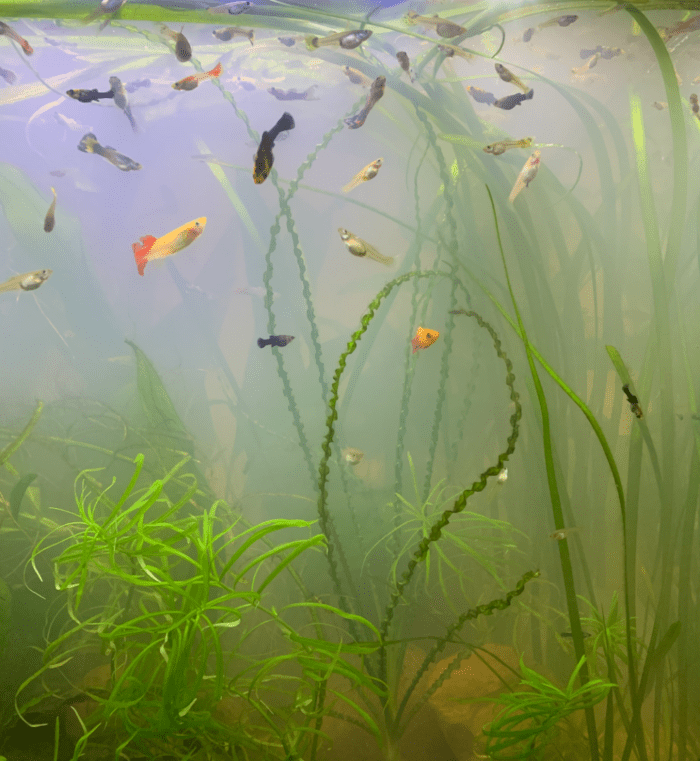
Before you apply any of the methods I’ve listed below, try to rule out if your problem wasn’t caused by something else. Cloudy water can be brought on by a variety of reasons other than a partial water change.
Many aquarium owners tend to feed their fish more than is needed.
This turns the leftover food into a bed for bacteria and a host of other unpleasant side effects.
Others neglect to trim the vegetation in their tanks which unsurprisingly leads to the same end results.
In some cases, the fault lies in the equipment and not the owner. Some water filters in freshwater aquariums might not be set up correctly and produce too much agitation which clouds the water.
Related: Why is your fish tank filter not working?
Faulty protein skimmers in marine setups could also make the water appear hazy by leaking microbubbles back into the aquarium.
Your aquarium water might also appear foggy because the Nitrogen cycle hasn’t been established yet.
This makes cloudy water a fairly common occurrence in new fish tanks. In these cases, the best course of action is to simply let nature run its course. It will probably take a few weeks for the water to clear.
Lastly, your aquarium might look cloudy as a result of a recent substrate change. If you put an inert substrate such as sand straight in your fish tank, without washing it first, then it can release fine particles that might pollute it.
In case the water is still dirty after 1 or 2 days, then the problem probably lies elsewhere.
If you’ve eliminated the above as possible culprits, then the following solutions will fix your problem:
- Perform a water change with Reverse Osmosis Water
Reverse osmosis is a process that purifies water by passing contaminants through a semipermeable membrane.
This also removes any organic compounds that might be present. By partially replenishing your freshwater aquarium with reverse osmosis water instead of tap water, you strip off heterotrophic bacteria from the vital nutrients they need to survive.
What’s more, there’s evidence which shows that some heterotrophs manage to survive in tap water, despite the disinfectants water treatment facilities use. It’s no wonder your fish tank keeps getting cloudy so fast.
The tap water you use not only provides heterotrophic bacteria with food but also serves as a vehicle for more of its kind. Even though reverse osmosis water is a great alternative, it comes with a caveat.
The purification process it goes through also removes minerals that are essential for fish health.
As a result, you need to re-mineralize RO water before it can sustain live fish. This means adding a water conditioner that would replenish the lost mineral that are actually beneficial to your pet fish.
Seachem Equilibrium is one product that does just that. Anyway, keep in mind you shouldn’t change more than 15% of your water as it can disrupt the biological balance in your aquarium. - Use a different aquarium salt mix.
The chemical composition of some aquarium salt mixes can lead to cloudiness if they aren’t utilized properly.
Probiotic mixes, for instance, aren’t well suited for bigger water changes.
They contain live bacteria that can cause a bacterial bloom and fog up the water column.
If you’ve made the mistake of using probiotic salts to replenish more than 10% of your aquarium water, then it’s most likely they’re the cause of your issues.
Aquarium salt mixes that contain mined salts as a base, can also cloud the water in your fish tank.
That’s why you need to wait for a couple of hours before you can add the solution to your tank.
In both of these cases, it’s usually only a matter of time before the water clears itself
Let’s explore the pros and cons of Black Diamond blasting sand in aquariums in this article.
It’s a relatively cheap brand that can be used immediately after mixing, without clouding your water.
On some occasions, adding the salt mix to the solution creates tiny particles that resemble snowflakes.
These particles are a result of Calcium Carbonate precipitation which usually happens when the saltwater wasn’t mixed properly. The easiest way to get rid of the cloudiness, in this case, would be to perform a water change with a magnesium-enriched saltwater solution.
Without getting into too many technicalities, this essentially reduces the likelihood of Calcium Carbonate (CaCO3) precipitation.
The magnesium must be added before the saltwater mix, so it has time to fully dissolve. Otherwise, it won’t achieve the desired results and you’ll end up in the same place as you started.
The best and most affordable way to supplement your water with magnesium is to use Magnesium Sulfate (MgSO4).
There’s no need to worry if the chemistry isn’t your strong suit.
You’ve most probably encountered magnesium sulfate in pharmacies sold as Epsom Salt.
The last thing you should keep in mind when using magnesium sulfate is that it dissolves rather slowly so you’ll need to stir it quite a bit.
My Final Thoughts
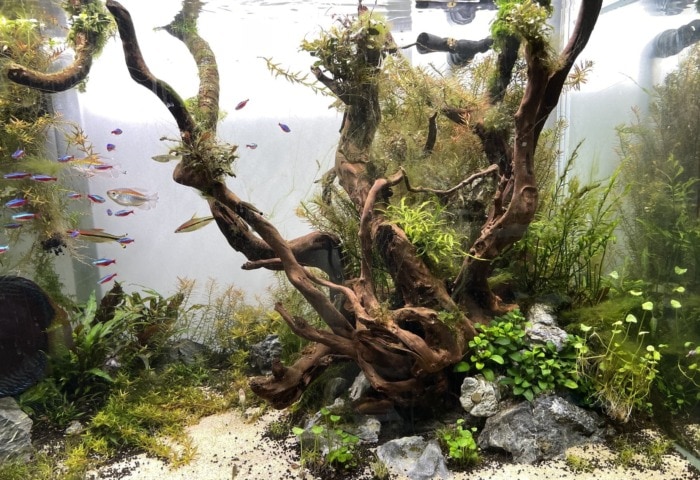
When we envision the aquarium of our dreams, we picture it full of gorgeous, colorful fish which swim about undisturbed.
The last thing on our minds is how changing water can turn our dreams into ruin.
However, by taking a few simple steps, we can avoid cloudy aquarium water once and for all.
I hope this article has cleared both your confusion and your fish tank.
And as always, don’t forget to leave your thoughts down in the comments.



